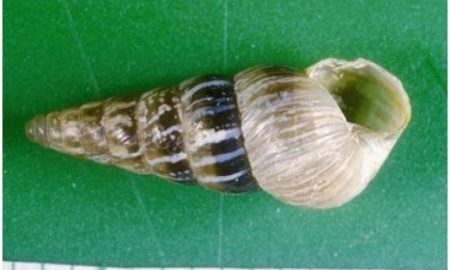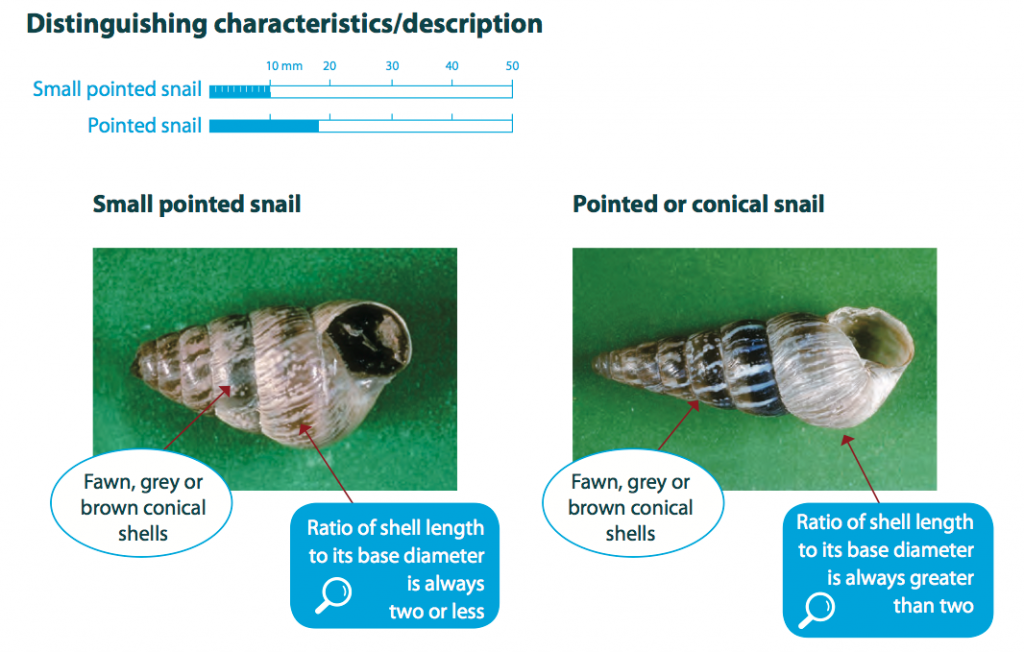Pointed snail
Cochlicella acuta
Other common names
Conical snail

Photo by SARDI
Summary Top
Conical or pointed snails have rarely been recorded feeding on crops or pasture, preferring dead organic matter as a food source. However, they are a contaminant of grain, particularly barley. During summer they can be found under stones and stumps, and on posts and vegetation, in cereal stubble and at the base of plants in the ground.
Snail numbers can build up in the pasture phase of cropping rotations.
Occurrence Top
An introduced snail of European origin, the conical or pointed snail is found in the highest numbers on Yorke Peninsula in South Australia. Isolated populations are also found in coastal areas of SA, New South Wales and Western Australia as well inland areas of Victoria. This species of snail is particularly favoured by calcareous and highly alkaline soils, retained stubble and no tillage. Moist seasonal conditions may also favour conical snails.
Description Top
Conical or pointed snails are fawn, grey or brown in colour. Mature snails have a shell length of up to 18mm with the ratio of shell length to its diameter is always >2.

Lifecycle Top
The life cycle of snails is extremely dependent on and linked to behaviour and these should not be considered separately. Conical snails are hermaphrodites, thus each snail has both male and female reproductive organs. This gives every snail the potential to lay eggs after mating. Under optimal environmental conditions and food availability each snail is capable of laying hundreds of eggs each season. However, the number of eggs laid is highly variable and dependent on the conditions prevalent in a particular season. Given optimal conditions, snail populations can increase rapidly.
Commencement of egg laying is dependent on soil moisture content. Moisture, either from heavy dews or rainfall will trigger snails to become active and descend from over-summering (aestivation) sites on stubble, fence posts and vegetation to the soil. Conical snails also aestivate under stones and stumps sealing their operculum to prevent moisture loss. Conical snails generally activate later in the autumn than round snails co-occurring in the same paddock. If cool conditions persist, snails may remain on the soil surface to feed. It appears that the first decent rain fall in autumn triggers mating. If the soil remains moist, egg laying commences, usually in April, finishing in September but this timing varies between regions and seasons. No egg laying occurs during summer even with rain as the snails’ reproductive organs have not reached maturity at this time.
Clusters of milky white eggs are laid in shallow holes in the soil. One snail can lay several clusters per season. Eggs hatch after about 2 weeks. Hatchlings are about 1 mm in size and are often found in groups.
Rainfall in the current year impacts on spring populations in that year and on autumn populations in the following year.
Similar to Top
Immature snails can be confused with small pointed snails (see images above) and native conical snail species.
Crops attacked Top
Generally, conical or pointed snails do not directly damage crops, since they mostly feed on dead organic matter. They are typically a pest at harvest as a contaminant of grain, particularly of barley.
Damage Top
Generally conical or pointed snails cause no direct damage to crops.
Monitor Top
Monitor for feeding activity prior to baiting early in the season. Concentrate on areas where limestone ridges occur close to the soil surface as these are areas where populations occur in greatest densities.
The importance of monitoring to determine feeding activity cannot be over emphasised.
Economic thresholds Top
The use of thresholds for snails is not relevant as good snail management requires population reduction at every opportunity.
Management options Top
Biological
A parasitic fly Sarcophaga pencillata which targets conical or pointed snails, was introduced into South Australia from Europe during 2001-3. To date there is no evidence to suggest this has had an impact on snail populations.
Cultural
There are several cultural control options. These appear in detail in Bash’Em Burn’Em Bait’Em – Integrated snail management in crops and pastures.
In summary there are two approaches to cultural control.
• Bash’Em. As snails over-summer on any object above the soil surface to escape summer soil temperatures, stubble management by cabling, rolling or slashing is designed to bring the snails to the soil surface where they desiccate and die. The higher the temperature when these processes are carried out, the more likely those snails will die. For effectiveness, air temperatures should be above 35°C. This process loses its effectiveness when the snails are in the soil and/or at the base of plants.
• Burn’Em. This is the most effective method of snail control pre-breeding. An even burn is most effective. As snails are often beneath rocks, these should be turned before burning, and summer weeds should be browned-off. While burning stubble is seen as advantageous in destroying weed seeds, stubble harboured diseases and snails, it is also detrimental in that it destroys beneficial soil organisms and reduces organic matter. Burn only when fire restrictions permit.
Snails have been found along all major transport routes between South and Western Australia, especially in camping grounds and at intersections along these roads. This suggests snails have become proficient hitch-hikers and are moving between regions on transport.
To avoid moving snails from infested to clean areas, farm machinery and produce such as hay should be inspected and if necessary cleaned of snails.
Chemical
Commercial snail baits are available for snail control. Choice of bait is dependent on which products are registered for use in your state. Consult the product label. Label rates must be adhered to.
- Timing of application is critical for success and is dependent on snail feeding.
- Control weeds that offer a refuge for snails before baiting.
- Commence baiting following rain or heavy dews in March as snails may not always feed after summer rain.
- Baiting before seeding is more effective as the bait will be the only food available.
- Ensure baits are spread evenly.
- Trials have shown that if using a fertilizer spreader, baits can only be spread 18-24 metres and it is important to ensure total coverage.
- Monitor snail numbers across the paddock and adjust bait rates accordingly.
- Bran based baits need to be applied regularly, at least every two weeks. More expensive extruded products last up to a month.
- After spreading bait, check the spread and the amount of bait used. This will indicate if follow-up baiting is required.
- Follow-up moisture may cause egg laying to begin within 2 weeks and it is essential to apply bait before this occurs.
Controlling snails before egg laying commences is essential.
Acknowledgements Top
This article was compiled by Helen DeGraaf (SARDI) and Bill Kimber (SARDI).
References/Further Reading Top
Bailey PT. 2007. Pests of field crops and pastures: Identification and Control. CSIRO Publishing, Melbourne, Australia.
Baker G. and Hopkins D (eds). 2003. Bash’Em Burn’Em Bait’Em – Integrated snail management in crops and pastures. GRDC, SARDI, SAGIT. https://www.grdc.com.au/uploads/documents/Snails%20BBB.pdf
Henry K, Bellati J, Umina P and Wurst M. 2008. Crop Insects: the Ute Guide Southern Grain Belt Edition. Government of South Australia PIRSA and GRDC.
| Date | Version | Author(s) | Reviewed by |
|---|---|---|---|
| March 2015 | 1.0 | Helen DeGraaf (SARDI) and Bill Kimber (SARDI) | Michael Nash (SARDI) and Garry McDonald (cesar) |
What are PestNotes?
PestNotes are information sheets developed through a collaboration between Cesar Australia and the South Australian Research and Development Institute (SARDI). Copyright: © All material published in PestNotes is copyright protected by Cesar Australia and SARDI and may not be reproduced in any form without written permission from both agencies.
Disclaimer
The material provided in PestNotes is based on the best available information at the time of publishing. No person should act on the basis of the contents of this publication without first obtaining independent, professional advice. PestNotes may identify products by proprietary or trade names to help readers identify particular products. We do not endorse or recommend the products of any manufacturer referred to. Other products may perform as well as or better than those specifically referred to. Cesar Australia and PIRSA will not be liable for any loss, damage, cost or expense incurred or arising by reason of any person using or relying on the information in this publication. Any research with unregistered pesticides or products referred to in PestNotes does not constitute a recommendation for that particular use.

